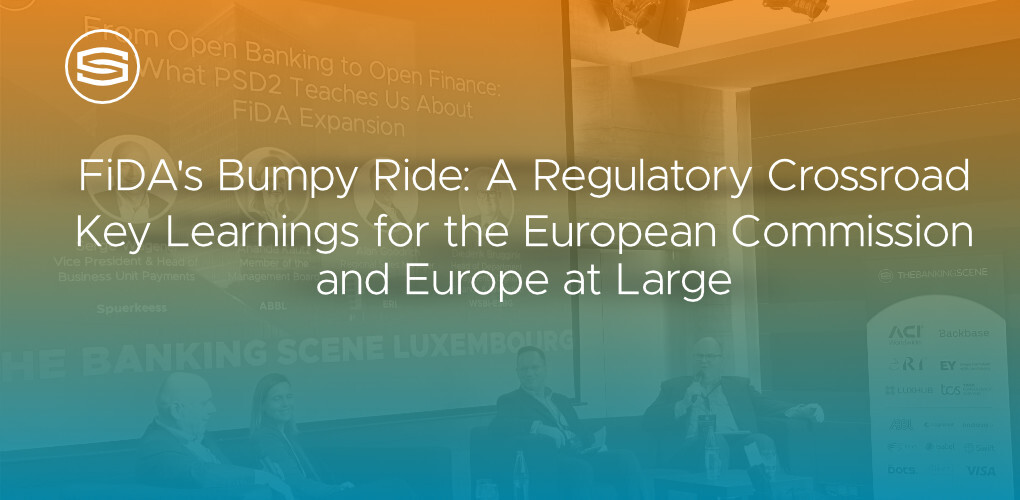
Insights & Opinions
FiDA’s Bumpy Ride: A Regulatory Crossroad – Key Learnings for the European Commission and Europe at Large
Mon, 17 Feb 2025


The Financial Information Data Access (FiDA) regulation remains a highly debated initiative in the European financial landscape. On February 10, Politico predicted the regulation was on the verge of being scrapped from the European Commission’s 2025 work program, and one day later, FiDA has ultimately made its way back to the legislative agenda, according to a communication from the European Commission.
The close call highlights unresolved concerns around its scope, cost implications, and real-world applicability. As the European Commission refines its approach, the financial services industry believes it must take a step back and critically assess whether FiDA, in its current form, is the right instrument to drive financial innovation and competition.
Discussions at The Banking Scene Conference 2025 Luxembourg, 2 weeks earlier, offered valuable insights into the regulatory challenges of FiDA. Experts from banking, fintech, and regulatory bodies debated the feasibility of the regulation, ultimately underscoring the need for a more targeted and market-driven approach.
This article consolidates the key takeaways from that debate, outlining recommendations for the European Commission as it navigates the next phase of FiDA’s legislative process.
Regulation Alone Won’t Drive Innovation – Market-Driven Models Are Key
A recurring theme from the panel discussions was that regulatory mandates alone are insufficient to spark meaningful innovation or proactive industry buy-in. The introduction of PSD2 demonstrated that requiring banks to open access to financial data does not automatically generate new business models or consumer demand. Open banking adoption remains low years after its implementation, with limited consumer uptake and unclear revenue streams for financial institutions.
For FiDA to be effective, it must go beyond compliance and foster an ecosystem where financial players see commercial incentives to participate. Rather than imposing rigid frameworks, the European Commission should explore voluntary participation models, providing flexibility for institutions to innovate at their own pace while ensuring a level playing field.
Initiatives like SPAA could spark an interest in innovation and incentivisation are properly balanced.
The Business Case for FiDA Remains Weak
That brings us to the next challenge. While open banking regulations aimed to democratise financial data, they have struggled to produce viable business cases, particularly for smaller banks. The panel discussion highlighted that, without clear monetisation opportunities, FiDA risks becoming another costly compliance exercise rather than a driver of financial services evolution.
The European Commission must take a pragmatic approach by collaborating with industry players to identify realistic revenue models and ways to excite the industry to sign up for these new schemes.
A phased implementation—starting with high-impact areas such as creditworthiness assessment and SME financing—could allow for targeted innovation while avoiding unnecessary regulatory burdens on sectors where demand remains uncertain, think of pensions and insurance products.
FiDA’s Scope is Too Broad and Needs Refinement
That brings us seamlessly to point 3. One of the most pressing concerns raised was the overly ambitious scope of FiDA. Unlike PSD2, which focused primarily on payments, FiDA seeks to extend data-sharing requirements to insurance, pensions, investments, and wealth management. This broad reach introduces significant technical and operational challenges for industries that are not always fully digitised.
Many insurers and pension providers still rely on legacy systems and paper-based processes, making them ill-prepared for mandatory data-sharing regulations. A more measured approach would involve a staged rollout, prioritising already data-rich sectors and capable of integrating open finance models efficiently.
The other path is a slowdown for the entire industry, which would be devastating for the already little enthusiasm that exists in banks regarding FiDA today.
Standardisation and Interoperability Must Be Addressed First
A key shortcoming of PSD2 was the fragmentation caused by a lack of standardisation. Banks, fintechs, and regulators struggled with differing API specifications, leading to inconsistent user experiences and operational inefficiencies. Without a unified technical framework, FiDA risks repeating these mistakes, exacerbating the very barriers it aims to eliminate.
Before imposing widespread compliance requirements, the European Commission should prioritise the development of standardised APIs and governance models across member states. Establishing clear technical guidelines in collaboration with industry stakeholders would create a more seamless data-sharing infrastructure, ultimately fostering greater adoption and competition.
Top-Down Regulatory Mandates May Hinder, Not Help
Financial innovation has historically thrived when market forces, rather than regulatory mandates, drive progress. The rise of embedded finance, Buy Now, Pay Later (BNPL) services, and mobile payments were all propelled by consumer demand and competitive pressures, much less by regulatory intervention.
FiDA, in its current form, risks stifling organic innovation by imposing prescriptive data-sharing requirements on financial institutions that may not see clear benefits. Instead of mandating broad data access, the European Commission should incentivise voluntary collaboration between banks and fintechs through regulatory sandboxes, pilot programs, and tax incentives for innovation-driven projects.
By stimulating creativity, FiDA may find plenty of hidden opportunities, although we do understand a push is needed, as the majority of the financial services industry may prefer a standstill in this respect instead, given the focus on regulatory compliance and cost reductions we see today.
Banks See Big Tech as the Real Competitor – Where’s the Level Playing Field?
The most immediate competitive threat in financial services does not come from fintech startups but from Big Tech giants such as Google, Amazon, Apple, and Facebook. These companies already have significant influence over digital payments, and with FiDA, they could gain even greater access to financial data, further consolidating their dominance.
Banks argue that, unless non-bank entities are subject to the same regulatory obligations, FiDA could unintentionally create an uneven playing field where traditional financial institutions bear the brunt of compliance costs while Big Tech reaps the benefits.
Any regulatory framework should ensure that all participants, regardless of industry origin, operate under consistent rules to prevent market distortions.
Final Thoughts: A Smarter Path Forward for FiDA
The European Commission now faces a critical juncture in shaping the future of financial data access. Rather than pushing forward with an overly broad and compliance-heavy approach, policymakers should take a more nuanced stance by:
- Refining FiDA’s Scope: Focusing first on data-sharing models that provide clear consumer benefits and business incentives.
- Ensuring Business Viability: Collaborating with financial institutions to develop sustainable revenue models for open finance services.
- Standardising Before Regulating: Establishing common technical frameworks to prevent market fragmentation.
- Encouraging Innovation, Not Just Compliance: Using incentives rather than rigid mandates to drive adoption.
- Leveling the Playing Field: Ensuring that all financial service providers, including Big Tech, are held to the same regulatory standards.
As the legislative process progresses, the European Commission must accept these lessons from PSD2 and industry feedback to craft a regulatory framework that truly fosters financial innovation rather than imposing unnecessary burdens. Only by striking the right balance between regulation and market-driven incentives can FiDA achieve its intended goal of empowering consumers while ensuring a dynamic and competitive financial ecosystem in Europe.
Join us at our flagship conference in Brussels on May 22, where we will be digging deeper into the potential impacts and implications of FiDA, and industry leaders will share their insights on top-of-mind topics for banking, payments, fraud and fincrime professionals today.



